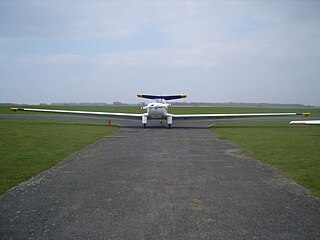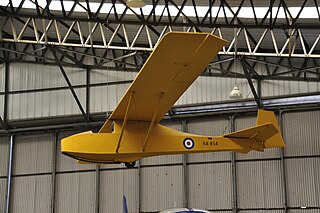Related Research Articles

The Slingsby Hengist was a British military glider designed and built by Slingsby Sailplanes Ltd. Like other British troop carrying gliders in the Second World War, it was named after military figures whose name began with H, in this case the Jute invader Hengist.

The Vickers-Slingsby T-65 Vega is a 15-metre class class glider which first flew on 3 June 1977. Of fibreglass construction, it features linked camber-changing flaps and airbrakes, and a retractable main and tailwheel.

The ICA IS-28 is a two-seat sailplane produced in Romania in the 1970s. An all-metal aircraft of conventional design with a T-tail, it was originally produced with 15-metre wings, but in 1973, production shifted to the IS-28B with 17-metre wings and numerous aerodynamic refinements. These included a smaller tail with decreased dihedral, decreased dihedral on the wings, and redesigned fuselage contours. This version first flew on 26 April 1973 and was subsequently produced in versions with flaps (IS-28B2) and without (IS-28B1). Around 100 had been built by the early 1980s, with a substantial number sold for export. On April 7, 1979, Tom Knauff and R. Tawse set a world record with the IS-28 B2 glider, covering a distance of 829 kilometres on a predetermined out-and-return course from the Ridge Soaring Gliderport in Julian, Pennsylvania.

The HP-14 is a Richard Schreder-designed all-metal glider aircraft that was offered as a kit for homebuilding during the 1960s and 1970s. It was originally developed by retrofitting improved wings to the fuselage and tail of the HP-13. Schreder won the 1966 US national soaring championship in the prototype HP-14.

The Slingsby T.7 Kirby Cadet is a British training glider designed and built by Slingsby that first flew in 1935 and saw service with the Royal Air Force for use by the Air Training Corps as the Cadet TX.1 throughout the 1950, 1960s and 1970s.

The T.31 Tandem Tutor is a British military training glider, designed and built by Slingsby and used in large numbers by the Air Training Corps between 1951 and 1986.

The Slingsby T.21 is an open-cockpit, side-by-side two-seat glider, built by Slingsby Sailplanes Ltd and first flown in 1944. It was widely used by the RAF, Sri Lanka Air Force and by civilian gliding clubs.
The Slingsby T.9 King Kite is a British glider designed and built by Slingsby that first flew in 1937.

The Slingsby T.41 Skylark 2 was a sailplane produced from 1953 by Slingsby Sailplanes at Kirkbymoorside, Yorkshire.

The Slingsby T.37 Skylark 1 was a small low-cost sailplane built during 1952-3 at Kirbymoorside, Yorkshire by Slingsby Sailplanes.

The Slingsby T.3 Primary was a single-seat training glider produced in the 1930s by Fred Slingsby in Kirbymoorside, Yorkshire.

The Slingsby T.4 Falcon 3 was a two-seat training glider produced from 1935, by Fred Slingsby in Kirbymoorside, Yorkshire.

The Slingsby T.6/T.23 Kirby Kite was a single-seat sport glider produced from 1935, by Fred Slingsby in Kirbymoorside, Yorkshire.

The Slingsby T.29 Motor Tutor was a single-seat motor glider produced from 1948, by Slingsby Sailplanes in Kirbymoorside, Yorkshire.

The Slingsby T.8 Kirby Tutor was a single-seat sport glider produced from 1937, by Fred Slingsby in Kirbymoorside, Yorkshire.

The Slingsby T.12 Gull was a British single-seat glider designed and built by Slingsby Sailplanes and first flown in 1938.
The Slingsby T.25 Gull 4 is a British glider designed and built by Slingsby that first flew in 1947.
The Slingsby T.1/T.2 Falcon or British Falcon) was a single-seat sport glider produced, in 1931-37, by Fred Slingsby in Scarborough, Yorkshire.

The Slingsby Type 34 Sky is a high performance single seat competition sailplane built in the United Kingdom. It was successful in major events, particularly in the World Gliding Championships of 1952.

The Slingsby T.59 Kestrel is a British Open class glider which first flew in August 1970. Of fibreglass construction, it features camber-changing flaps, airbrakes, and a retractable main wheel.
References
- Taylor, J. H. (1989). Jane's Encyclopedia of Aviation. London: Studio Editions. ISBN 0-7106-0017-8.
- Simons, Martin (1996). Slingsby Sailplanes. Shrewsbury: Airlife. ISBN 1-85310-732-8.